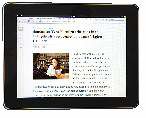Apps are altering the way we consume digital publications
Published 4:00 am Tuesday, February 1, 2011

- An iPad displays an article after it has been stripped down by the Readability tool.
The DVR rocked the world of television by letting viewers skip commercials and build their own home viewing schedules. Now a handful of Web services and applications are starting to do much the same thing to online publishers.
These tools make it easier for people to read Web articles how, when and where they want, often dispensing with carefully arranged layouts and advertisements of publishers.
One popular tool, Readability, strips articles to the bare minimum of text and photographs with a single click. But now, Readability wants to give something back to publishers.
Today, the developers behind the tool will unveil a service that requires a subscription fee of at least $5 a month. The service, also called Readability, plans to distribute 70 percent of that fee to the news outlets and blogs that each subscriber is reading.
For example, if a subscriber is a regular visitor to the gadget blog Gizmodo and the women’s news site The Hairpin over the course of a month, Readability will calculate what percentage of her payment should go to each site and send them checks.
“We were never about stripping ads or being an ad blocker,” said Richard Ziade, who created the original Readability tool as well as the second-generation version. Instead, he said, the company has been wondering: “Can we come up with a mechanism to make the experience of reading on the Web better, but also support content creators and publishers?”
Readability is one of many services experimenting with the future of reading. A wave of applications, including Pulse, Flipboard and My Taptu, are responding to changes in how people prefer to read on the Web, putting articles and blog posts into cleaner or more attractive visual displays.
Whenever, wherever
Nate Weiner, founder of Read It Later, a Web and mobile service that saves articles to be read offline, said there was a larger shift under way, one that mirrors the move to digital from print. Instead of thumbing through the newspaper over breakfast, he said, people like to read articles from many sources on their commutes or in the evening, often using mobile devices.
“People don’t really want to have to be confined to a specific place, time, site or device to read content,” Weiner said.
Weiner recently analyzed data from his service, which has 3 million users, and found those who owned an iPhone or iPad preferred to save articles for a personalized prime time. IPad reading, in particular, peaks from 8 to 10 p.m.
The glut of updates flowing across the average person’s computer and mobile screens throughout the day, either through social networks or links e-mailed by friends, is also driving the trend.
“If you’re a modern worker, you’re constantly being bombarded with information that you want to read, but that environment is not always the appropriate or best time to read that information,” said Joshua Benton, director of the Nieman Journalism Lab, which is affiliated with Harvard.
Gaining traction
Ziade of Readability acknowledged there were still many things to be ironed out with the new service, including how often to distribute payments and what happens if publishers refuse to accept the collected money.
The company plans to pay them “regardless of their participation,” he said. Should a site refuse the money, the company is considering options like contributing it to a charity or literacy organization.
Ziade, who is a partner at a consulting company in Manhattan called Arc90, developed Readability as a pet project in March 2009 and released it online for others to use free; the code is available under an open-source license.
Since then Readability has gained traction among users — and among hardware and software makers. Apple now builds it into its Safari browser, Amazon uses it in the Kindle, and it is built into several mobile applications, including Flipboard, Pulse and Reeder. Ziade said it was difficult to track how many people were using the tool, but thousands of people visit the Readability home page each day.
Though the original Readability tool will remain free, Ziade hopes to capture a willing audience by simplifying the micropayment model, which has been much discussed but is tricky to execute.
“Asking someone to pay 45 cents to read an article may not be a big deal, but no one wants to deal with that transaction,” he said. Marco Arment, an adviser to Readability and the creator of Instapaper, a service for saving and reading online articles, made a version of his Instapaper app that will essentially be Readability’s mobile component. Arment said he thought the most likely customers for Readability’s pay service were “online power readers.”
“It’ll be the types who buy print magazines even though the same articles are online for free, just because they want to support the publication,” he said.
“On the Web, it’s not that people aren’t willing to pay small amounts for things; it’s that there is no easy way to pay,” he added. “If a service like Readability comes along and makes it easy, I think people will be willing to pay.”






